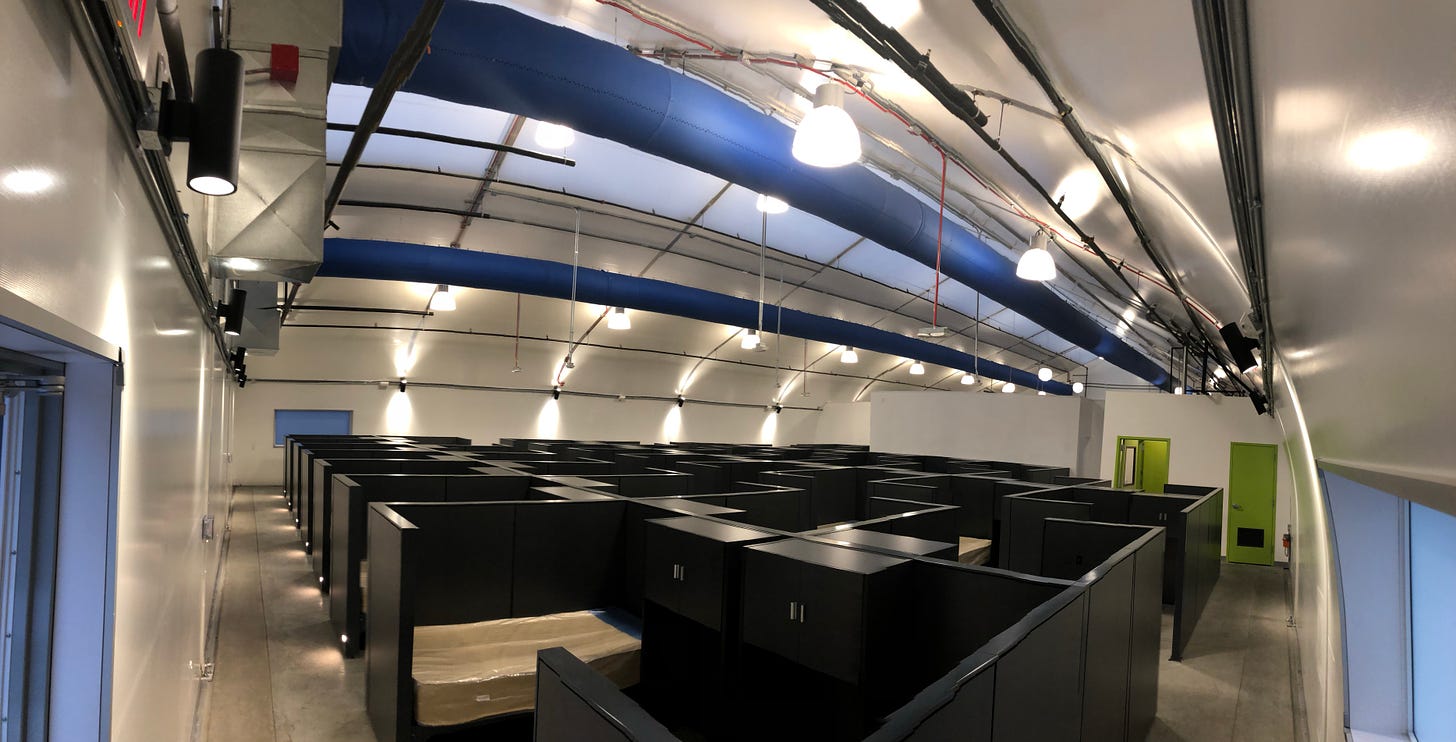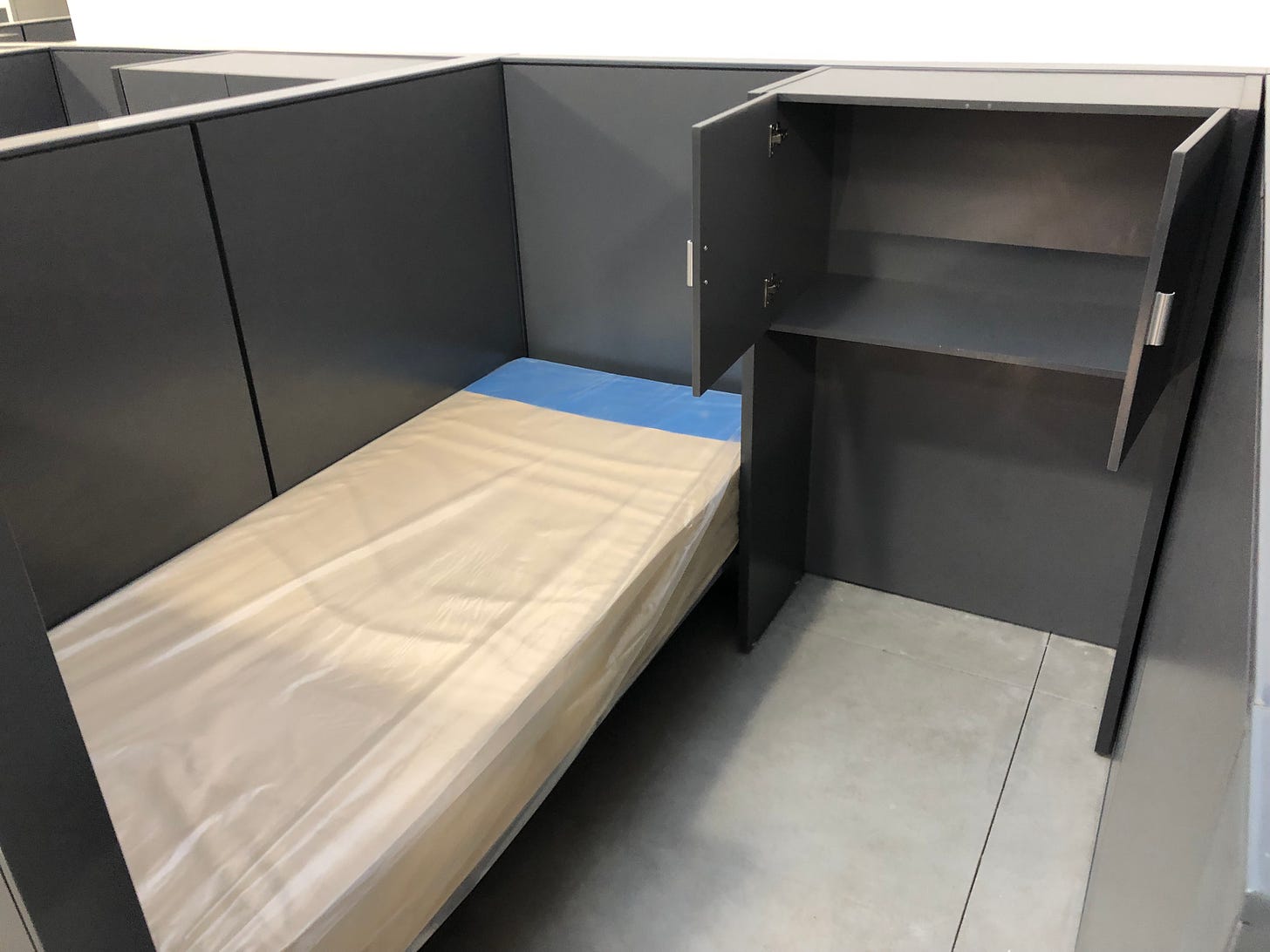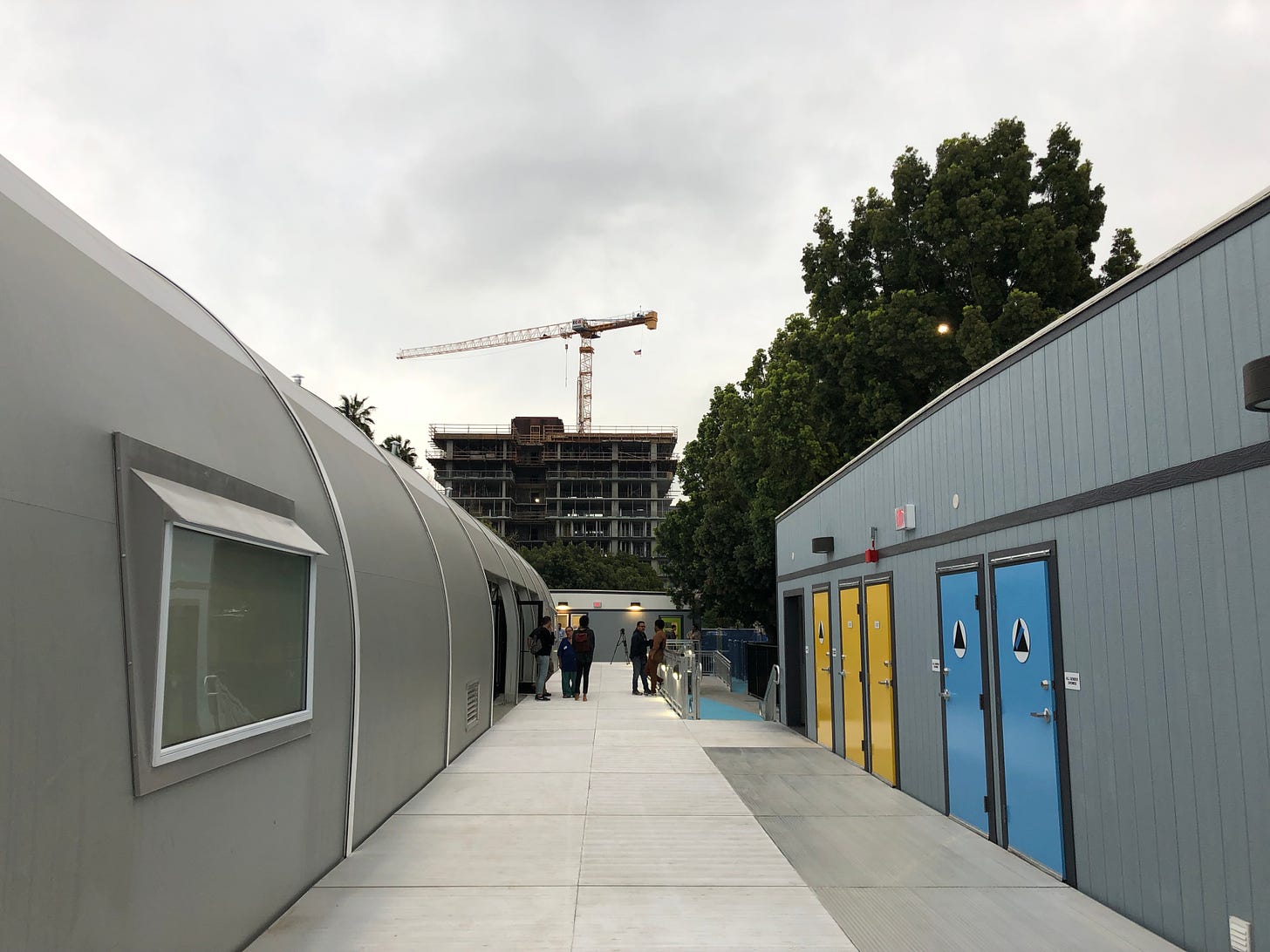The Steep Cost Of Building More Shelters
As the saying goes: shelter doesn't end homelessness; housing ends homelessness.

Henry Lenhart has celebrated not one, but two birthdays in his 48 square-foot “cube” at the “A Bridge Home” homeless shelter on Schrader Boulevard in central Hollywood. He is 60 years old.
“I need to get out of here. It's getting old. It's just a waiting game. Wait, wait, wait. Hurry up and wait. The story of my life," said Lenhart.
He says he’s been homeless for about four years. Originally a general contractor from New York, a turbulent living situation with no good alternatives sent him to the street. He went first to Florida for about a year, and then came to California after one of his friends suggested it might be easier to find housing out west. It didn’t pan out, and Lenhart ended up living on the street in Hollywood until he was offered a place at the second “A Bridge Home” shelter to open in Los Angeles, back in 2019.
“I've been here almost two years — two years in March. And I haven’t moved even an inch. These case managers, with all their computers and laptops, and they can't get me into somewhere? The system is broken,” he said from the bathroom of the shelter — one of the few places he can get some privacy.
“I'm just puzzled at the mere fact that, well, why am I still existing here?”
It’s a good question. Over the last two years, Lenhart says he’s cycled through three different case managers. The first two either quit or were reassigned. The third, Lenhart says is in over her head and struggling to navigate a vast, complicated bureaucracy. For a single 60-year-old man, L.A.’s system has few options that look much different than the shelter he’s already in.
So, he stays in his cube, together in a big room with about 70 other people. Outside of the bathroom, he’s never alone. The space is subdivided into small cubicle-like spaces with a bed and cabinets for storage, but the partition walls are only about five feet high. Sound carries.
Moreover, in the time he’s lived there, conditions inside have deteriorated. Maintenance on the large tent-structure and its facilities gets delayed, and Lenhart says pests like bedbugs and mice have moved in alongside the human occupants.
“I have to mouse-proof my house every time I leave there,” he said.
Even with the mice, the shelter is a step up from the street. He gets three meals a day and doesn’t have scramble to go to the bathroom. But two-years on, he feels trapped with no good alternatives.
“It's very bad. I need to get up and out of here like yesterday.”
Interim housing, like the “A Bridge Home” sites, are marketed as a proverbial “bridge” between the street and permanent housing. Definitions of “permanent housing” vary, but it typically means that someone who had previously been homeless now has their name on a lease, and the financial ability (often with public subsidies) to make rent each month.
When Los Angeles embarked on its latest effort to build more shelters in 2018, officials (and contracting documents) anticipated people moving through the sites in about three months. At a ribbon cutting of a new shelter live-streamed last summer, L.A. Mayor Eric Garcetti painted a picture of how interim housing supercharged ending homelessness:
“These beds aren't just one-time affairs. Every bed can recycle to a second and a third and a fourth and a fifth person, and so on and so forth, with the case management on site… and all the things we can do.”
Reality, of course, is far less efficient than the portrait painted by the Mayor’s words. The bed Lenhart occupies tonight is yet-to-be recycled for another user. And while Lenhart is something of an exceptional case for having stayed in the shelter for so long, most people who enter an “A Bridge Home” site do not leave for permanent housing.
I reported on this issue last summer when I was with KPCC/LAist. The L.A. Times followed a few months later with the bombshell statistic that just 15% of those exiting the “A Bridge Home” sites left for permanent housing. (The Times also found “31% of those leaving the shelters went back to the streets and 35% to unknown destinations.”)
These outcome numbers are about par for interim housing and shelter across the country. Without a room or apartment or other stable housing situation ready for a client on the other side of the “bridge,” people get stuck in what was supposed to be a temporary situation. Many opt to leave instead of staying for the long haul.
At a different ribbon-cutting last summer, Mayor Garcetti said “A Bridge Home” sites are “a place that would give you all that you needed to feel human again, and get your life back on track.”
But nearly two years sleeping on the “bridge” has left Lenhart feeling as if he has little life to get back on track. As a single adult male, he qualifies for fewer public assistance programs than others who are, on paper, more vulnerable. While he has some income, it’s not enough to lease an apartment. He has considered leaving Los Angeles and returning to New York, but he faces the prospect of being homeless there, too.
So, he’s stuck in-between: “I'm in limbo, you might say — how can I put it? Not enough to get here, but not enough to go there?”
On the promises made that someone would help him at the shelter, he said: “They like to fill your head full of bullshit dreams that are never ever gonna come around,”
So far, the City of Los Angeles has spent more than $200 million on the “A Bridge Home” program, largely using grant money from the State of California. That sum is almost entirely the cost of capital construction — the price of building more than two-dozen new congregate shelters.
But outside of construction costs, it also costs a lot to operate the sites. In shelters like “A Bridge Home,” operating costs are typically calculated through a daily “bed rate” that can range from $45-$80 depending on the specific suite of services provided.
At the Schrader site, where Henry Lenhart lives, the daily per-bed rate is $60, according to city documents. Most of this money is sourced from the 1/4 cent Measure H sales tax voters passed in 2017.
Some back of the napkin math (365 days multiplied by $60, divided by 12 months) produces a rough monthly public cost for Lenhart’s 48 square-foot cube of $1,825. That is nearly $300 dollars-a-month more than what I pay to rent a well-maintained 1-bedroom apartment less than two miles from the Schrader shelter. (Meanwhile, the shelter cost the City of L.A. $4.4 million to build, according to a report from the City Administrator’s Office.)
To some extent, the math I did in the previous paragraph is comparing apples to oranges. My apartment doesn’t come with three prepared meals each day, nor does it have on-site case-management that helps me access public resources like Medi-Cal and CalFresh. (Though, having spoken to several residents of the Schrader site, as well as other “A Bridge Home” shelters, residents often question if the services provided are actually helping them end their homelessness.)
But my apartment is over 600 square-feet, and is otherwise a pleasant and private place for me to be. Besides literally costing less than Lenhart’s 48 square-foot cube, it’s an order of magnitude more livable. I don’t have to share a bathroom, and I have my own kitchen. Lenhart has neither of those things, and a fraction of the space.
This sort of math should raise caution flags against investing everything into interim housing. There exist many other options that, besides providing clients with a higher standard of living, can literally cost less.
A similar point was raised to me by Peter Lynn, who directed the Los Angeles Homeless Services Authority (LAHSA) until he resigned at the end of 2019. He says that given the limited resources Los Angeles possesses, it’s crucial to steer them towards actual housing rather than sinking it all into more interim housing and shelters.
“Interim housing is a more expensive intervention than housing people. And if people are getting stuck, then it's a really expensive way to keep people homeless. And that’s just not the goal,” said Lynn.
That is, Lenhart is still homeless today, despite nearly two years and more than $40,000 of public money invested into serving him with a 48 square-foot cube.
Conceivably, the $1,825 cost of sheltering Lenhart each month could go farther in rental subsidies. A $910 rental subsidy on top of his existing income would almost certainly be enough for Lenhart to lease an apartment with a bathroom and kitchen. The remaining $915 could conceivably be used to do the same for another person, too.

Lenhart’s experience of getting stuck in L.A.’s homeless service system is hardly unique, and is well understood by those who work in the sector. A “system analysis” released by LAHSA last year acknowledged this, and described bluntly how “placing more resources at the front door means there are fewer resources to support permanent housing placements.”
That analysis underscores how L.A. needs exit options for people already in temporary shelters — or tiny homes, or bridge housing, or interim housing — more than it needs more temporary shelter.
While politicians are eager to build new shelters1 and celebrate 70-something new beds with self-congratulatory ribbon-cuttings, the investment is only worthwhile if the infrastructure can actually serve as intended, and doesn’t become a long-term warehouse for people experiencing homelessness.
Lynn makes the case that the only point it’s probably appropriate to begin investing everything into shelter is if there are literally no other options for housing, or money to spend on shelter are limitless.2 Neither of those things are true in Los Angeles, which goes back to concentrating more on moving people through existing infrastructure to permanent housing than building more temporary shelters.
“If you don't keep a very close focus on the goal of housing people, it is easy for people to get stuck in interim housing. And that's not where you want people,” said Lynn.
In other words, Lenhart made it through the front door of the homeless service system, but the rest of the house hasn’t yet been built.
At the end of our conversation, Lenhart said desperately: “You pass the word on and just let somebody know that I gotta get out of here. That's all there is to it.”
Update, 4:45 p.m. 02/19/2020: After this story published, I solicited and received comment from the Los Angeles Homeless Services Authority, and its director Heidi Marston:
“Stories like Henry’s are a reminder of why we need balance in our system. Shelter without housing on the back end causes people to get stuck in shelter without a clear path out,” said Heidi Marston, Executive Director of LAHSA. “We know LA County needs over 500,000 units of affordable housing just to start keeping pace with the current demand. We need fast, scalable, and accelerated solutions from our government partners to bring more housing online so we can make sure folks like Henry can have a place to call home.”
Los Angeles politicians also typically engineer a “special enforcement and cleaning zone” (SECZ) around new shelters, they say to coax hesitant neighborhoods to “accept” the shelters. The SECZs are constitutionally questionable. Advocates for the homeless liken them to “banishment zones.”
Moreover, state law has been amended to exempt the construction of homeless shelters from frivolous litigation. It’s not so much that neighbors could sue and stall the construction of a shelter as it is elected officials want political cover for building shelters near NIMBYS.
For their part, plaintiffs suing in Judge David Carter’s court are advocating that money from Proposition HHH currently earmarked for “supportive housing” be reprogrammed for building interim shelter. This is something city Controller Ron Galperin has lightly advocated for in the past, too.
There are many housing options that offer a high standard of living for many homeless clients between shelter and “permanent supportive housing,” which is typically only appropriate for the sickest and most vulnerable people outside. Moreover, many people experiencing homelessness do not qualify for PSH.





The reason why interim housing doesn't work is because homeless people don't work. "WORK". That's the response get from the "unhoused. If they actually worked a job, they wouldn't be homeless. It's that simple.
"[He] came to California after one of his friends suggested it might be easier to find housing out west..." What the hell made him think he was going to find housing in Los Angeles, one of the most expensive cities in the country? And given that he hasn't found housing "out west," why is returning to New York or Florida not an option?